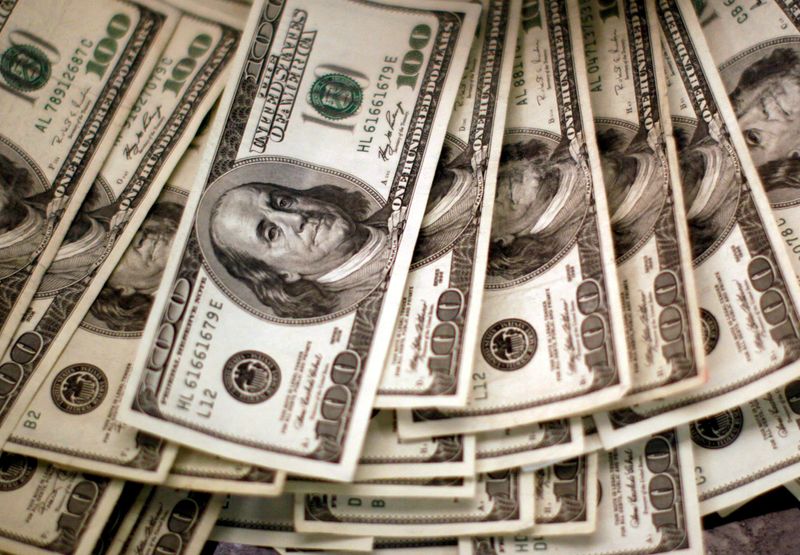Forex
Dollar’s smile makes Wall Street frown: McGeever


© Reuters. FILE PHOTO: Four thousand U.S. dollars are counted out by a banker counting currency at a bank in Westminster, Colorado November 3, 2009. REUTERS/Rick Wilking/File Photo
By Jamie McGeever
ORLANDO, Florida (Reuters) -The ‘dollar smile’ can be a blessing for Wall Street, or a curse.
Right now, with the dollar’s boom being driven by a destabilizing surge in U.S. bond yields, heightened uncertainty over global growth and rapidly deteriorating investor sentiment, it is definitely the latter.
The gist of the ‘dollar smile’ theory, floated by currency analyst and now hedge fund manager Stephen Jen 20 years ago, is this: the dollar typically appreciates in good times (booming investor confidence and roaring markets) and bad (times of great financial stress and ‘risk off’ markets), but sags in between.
U.S. economic outperformance in a solid global expansion attracting strong investment inflows into U.S. assets, and Treasury yields higher than their international peers is a recipe for strong dollar and buoyant Wall Street.
The circumstances that have fostered the dollar’s rapid rise since July could not be more different.
The Chinese, European and many emerging economies are creaking, fears are growing that aggressive Fed policy will ‘break’ something at home, and the explosion in real yields has left Wall Street – especially growth and tech stocks – shrouded in a mushroom cloud of worry and uncertainty.
In terms of the ‘dollar smile’, these are ‘bad’ times. There is a growing sense in markets that the negative relationship between U.S. stocks, the dollar, and yields could persist for months.
“I expect it to remain negative for the foreseeable future, that is the next three to six months,” reckons Stuart Kaiser, head of U.S. equity trading strategy at Citi. “This is a risk-off environment.”
Kaiser reckons returns have fallen by around 7.5% over the last two months. The dollar has accounted for 3.3 percentage points of that and the 10-year real yield 2.1 pp, easily the two biggest contributors, he estimates.
The dollar is up around 7% since mid-July and is on course to register its 11th consecutive weekly gain. That would be a record winning streak since the era of free-floating currencies began over 50 years ago.
It has had bouts of stronger appreciation, such as the early 1980s and 2014-15, but never a more consistent move higher. And with U.S. bond yields the highest in years and still outpacing their global peers, it may not be over yet.
FINANCIAL CONDITIONS TIGHTEN
A stronger dollar and rising bond yields, especially inflation-adjusted ‘real yields,’ in a “risk off” investment climate can scare the horses on Wall Street, potentially feeding a self-fulfilling spiral of selling and de-risking.
There’s no suggestion equities are about to crash. But the speed and extent of the move in the dollar and Treasuries, and tightening of financial conditions, warrant vigilance.
According to Goldman Sachs, U.S. financial conditions are the tightest this year. This is not dissimilar to other major economies and regions, some of which – the euro zone, China and emerging markets – are feeling an even tighter squeeze.
The bank’s U.S. financial conditions index (FCI) has risen 95 basis points since mid-July and the breakdown highlights how the dollar, yields and equities are feeding off each other.
Compare that with the 100 bps rise in the global FCI or 145 bps jump in the emerging market FCI from their lows on July 25, which have been driven almost entirely by higher short and long rates. The FX impact, positive or negative, has been negligible.
As Rabobank’s Jane Foley notes, the dollar’s historical inverse correlation with emerging market stocks – a decent barometer of risk appetite – is “reasonably” strong.
“This suggests that the dollar is set to find support on safe-haven demand even as the U.S. economy slows,” Foley wrote on Thursday.
If these dynamics intensify and momentum builds up a head of steam, the dollar’s strong exchange rate could also start to erode the dollar value of U.S. firms’ overseas income, potentially having a material impact on corporate earnings.
It might be too early for that to appear in third-quarter results – many big Wall Street firms will have hedged their currency exposure over the near term – but if sustained, fourth-quarter profits could be affected.
There might be less cause for concern in corporate America, especially the growth-sensitive and tech sectors that led the rally in the first half of the year, if the dollar’s surge was happening in a relatively stable fixed-income environment.
But nominal and inflation-adjusted long-term bond yields have rocketed, threatening future cash flows and profits. Another reason for investors to be cautious.
(The opinions expressed here are those of the author, a columnist for Reuters.)
(By Jamie McGeever; Editing by Andrea Ricci)

 Forex3 years ago
Forex3 years agoForex Today: the dollar is gaining strength amid gloomy sentiment at the start of the Fed’s week

 Forex3 years ago
Forex3 years agoUnbiased review of Pocket Option broker

 Forex3 years ago
Forex3 years agoDollar to pound sterling exchange rate today: Pound plummeted to its lowest since 1985

 Forex3 years ago
Forex3 years agoHow is the Australian dollar doing today?

 Cryptocurrency3 years ago
Cryptocurrency3 years agoWhat happened in the crypto market – current events today

 World3 years ago
World3 years agoWhy are modern video games an art form?

 Commodities3 years ago
Commodities3 years agoCopper continues to fall in price on expectations of lower demand in China

 Economy3 years ago
Economy3 years agoCrude oil tankers double in price due to EU anti-Russian sanctions





















